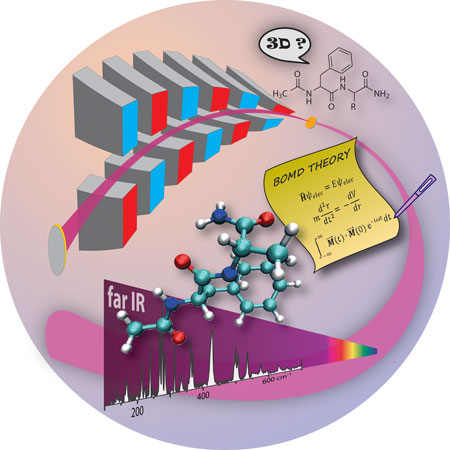| Feb 27, 2014 |
Peptides imaged in unprecedented detail
|
|
(Nanowerk News) Chemists from Radboud University Nijmegen and the Foundation for Fundamental Research on Matter (FOM) have succeeded in producing detailed 3D structures of selected peptides – the building blocks of proteins. To do this, they worked with far-infrared light produced by Radboud University Nijmegen’s laser FELIX, in use since 2013. The results, published online on 27 February in Angewandte Chemie ("Gas-Phase Peptide Structures Unraveled by Far-IR Spectroscopy: Combining IR-UV Ion-Dip Experiments with Born–Oppenheimer Molecular Dynamics Simulations"), are important for all the follow-up research on the structure elucidation of peptides and other classes of molecules.
|
 |
| The back cover of the April issue of Angewandte Chemie is devoted to the Nijmegen study, summarising the experiment in a nutshell. Very little is known about most molecular structures, represented by the 2D diagram to the top right. Using far-infrared light, this simple diagram can be converted into a 3D model. Far-infrared light was produced using the FELIX free electron laser (represented by the blue and red magnets). By studying the molecule using the laser, new information was obtained about the molecular structure. The chemists filtered this information out of the far-infrared spectrum using new theories (such as the BOMD theory on the Post-it Note). This allowed them to successfully convert the data from their experiments into realistic 3D models.
|
|
Physical chemists study the properties of molecules using a technique in which cooled molecules, isolated from their surroundings, are radiated with infrared light of varying frequencies. The result is a unique fingerprint of the structure of the molecule – the infrared spectrum. The Nijmegen chemists also did this but, for the first time, using far-infrared light – light with a wavelength of up to 0.1 millimetres. The result was a much more detailed infrared spectrum. Angewandte Chemie highlights the publication as a very important paper and fellow researchers from all over the world are eager to work with the methods described.
|
|
Familiar peptides, new results
|
|
The free electron laser in the FELIX lab at Radboud University Nijmegen is one of the few lasers in the world capable of producing light in the far-infrared region. Anouk Rijs, assistant professor at the Department of Molecular and Biophysics, was responsible for the research into common peptides in the human body. Although much is already known about these peptides, important new information can now be added. ‘What is new about our far-infrared spectrum is that we have obtained insights in the folding of the peptides in much more detail, as well as which interactions play a role in this. This is important, for instance, for research into interactions between medicines and molecules in the body. Without far-infrared light it is not possible to obtain such detailed information about the molecular structure.’
|
|
Theories inadequate
|
|
Chemists normally determine the molecular structure by comparing the measured infrared spectrum with theoretically predicted spectra. However, the new method produced so much more detail that the old theories and mathematical models were inadequate. ‘We therefore needed to develop new methods, which we did with colleagues from France,’ explains Rijs. ‘Using all this new information, we were able to produce an accurate 3D model of the peptides. The next step will be to study larger and more complex molecules.’
|

